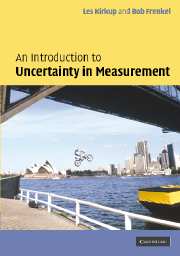 An Introduction to Uncertainty in Measurement
An Introduction to Uncertainty in Measurement Published online by Cambridge University Press: 06 July 2010
We live with uncertainty every day. Will the weather be fine for a barbecue at the weekend? What is the risk to our health posed by a particular item of diet or environmental pollutant? Have we invested our money wisely?
It is understandable that we would like to be able to eliminate, or at least reduce, uncertainty. If we can reduce it significantly, we become more confident that a desirable event will happen, or that an undesirable event will not. To this end we seek out accredited professionals, such as weather forecasters, medical researchers and financial advisers.
However, in science and technology uncertainty has a narrower meaning, created by the need for accurate measurement. Accurate measurement, which implies the existence of standards of measurement, and the evaluation of uncertainties in a measurement process are essential to all areas of science and technology. The branch of science concerned with maintaining and increasing the accuracy of measurement, in any field, is known as metrology. It includes the identification, analysis and minimisation of errors, and the calculation and expression of the resulting uncertainties.
Whether or not a measurement is regarded as ‘accurate’ depends on the context. Supermarket scales used for weighing fruit or vegetables need not be better than 1% accurate. By contrast, a state-of-the-art laboratory balance is able to determine the value of an unknown mass of nominal value one kilogram to better than one part in ten million. These figures, 1% in one case and one part in ten million in the other, are numerical measures of the degree of accuracy: low in the first case and high in the second, but each of them fit for its particular purpose.
To save this book to your Kindle, first ensure [email protected] is added to your Approved Personal Document E-mail List under your Personal Document Settings on the Manage Your Content and Devices page of your Amazon account. Then enter the ‘name’ part of your Kindle email address below. Find out more about saving to your Kindle.
Note you can select to save to either the @free.kindle.com or @kindle.com variations. ‘@free.kindle.com’ emails are free but can only be saved to your device when it is connected to wi-fi. ‘@kindle.com’ emails can be delivered even when you are not connected to wi-fi, but note that service fees apply.
Find out more about the Kindle Personal Document Service.
To save content items to your account, please confirm that you agree to abide by our usage policies. If this is the first time you use this feature, you will be asked to authorise Cambridge Core to connect with your account. Find out more about saving content to Dropbox.
To save content items to your account, please confirm that you agree to abide by our usage policies. If this is the first time you use this feature, you will be asked to authorise Cambridge Core to connect with your account. Find out more about saving content to Google Drive.